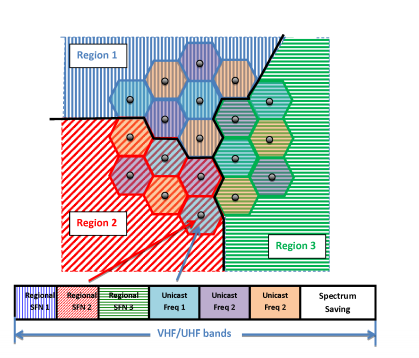The Future of TV–Terrestrial Broadcasting Or Video-On-Demand Over Cellular Networks?
One of the factors limiting the future of communications is bandwidth. In particular, mobile providers are greedily eyeing the 470-790 MHz frequencies currently used for conventional TV broadcasts.

The current model is to send the same data to all destinations, a process called broadcasting. So everybody watches the same content at the same time. The advantages of this system is that it guarantees everybody the same high level of service since they are all bathed in the same signal. It’s also relatively cheap to continue with because most people already have the necessary receiving equipment.
By contrast, there is a growing interest in sending different data streams to each user over a cellular network, a process known as unicasting. The big advantage here is that users get video-on-demand allowing them to watch whatever they want, whenever they like.
But there are disadvantages as well. It’s much harder to guarantee all users the same high level of performance, particularly those in rural areas at the edge of the network. What’s more, the infrastructure necessary to provide this cellular service is expensive both for providers to build and for users who will need to upgrade their own kit.
The question is how these various factors balance out given reasonable assumptions about future demand.
Today, Lei Shi at the KTH Royal Institute of Technology in Sweden and a few pals provide an answer. These guys have a name for the unicast-dominated option over a cellular network–they call it CellTV. Their sobering conclusion is that while CellTV has benefits, it is by no means clear that it makes sense to switch in the near future.
These guys approach the problem by modelling the future evolution of cellular networks and terrestrial TV broadcasting in Sweden. They argue that Sweden is an excellent example because it has a good combination of isolated rural districts and densely populated towns. It also has a highly developed cellular network as well as terrestrial TV coverage that rivals the best in Europe.
Lei and co begin with the statistics showing how these two systems are used now. They then make reasonable assumptions about the advances that will be possible with cellular networks by 2020 and then explore whether it makes sense to switch to a cellular-based TV system by then.
The key factor in all this is the way people watch television. Currently, a large number of viewers watch a small number of channels. This is ideal for a conventional terrestrial broadcasting system. However, video on demand allows a large number of channels to each be watched by a small number of viewers, a system that is ideal for cellular-based unicasting.
So a crucial question is how viewing habits are likely to change by 2020. Unfortunately, Lei and co do not have an answer to this. “Our analysis shows that CellTV can be beneficial if the current trend towards more specialized programming, more local contents, and more on-demand requests, continues,” they say.
But they also say: “Our work also shows that CellTV is not effective in replacing terrestrial TV broadcasting for the current TV viewing patterns. If the change in the TV service is more modest and linear content is still the major part of the offering, then the gain would be limited.”
In that case, the deciding factor will be the cost of changing the system. When all the costs are added up, their prediction is decidedly conservative. “It is doubtful that the expected spectrum saving can motivate the investments in both cellular sites and TV receivers,” say Lei and co.
So by this analysis, we’re going to have conventional terrestrial TV broadcasts for the foreseeable future.
The problem, of course, is that this is a chicken and egg situation. It’s hard to generate demand when the CellTV system does not exist and without the demand it’s hard to justify the investment.
There are other possibilities though. One is that the evolution of shortrange services, such as the next generation of wifi, will drive demand for unicast services and thereby shape the future of television. Another is that TV over fixed line broadband will come to dominate making terrestrial broadcasting obsolete. Only time will tell.
Ref: arxiv.org/abs/1303.4924: CellTV - on the Benefit of TV Distribution over Cellular Networks: A Case Study
Keep Reading
Most Popular
Large language models can do jaw-dropping things. But nobody knows exactly why.
And that's a problem. Figuring it out is one of the biggest scientific puzzles of our time and a crucial step towards controlling more powerful future models.
The problem with plug-in hybrids? Their drivers.
Plug-in hybrids are often sold as a transition to EVs, but new data from Europe shows we’re still underestimating the emissions they produce.
Google DeepMind’s new generative model makes Super Mario–like games from scratch
Genie learns how to control games by watching hours and hours of video. It could help train next-gen robots too.
How scientists traced a mysterious covid case back to six toilets
When wastewater surveillance turns into a hunt for a single infected individual, the ethics get tricky.
Stay connected
Get the latest updates from
MIT Technology Review
Discover special offers, top stories, upcoming events, and more.